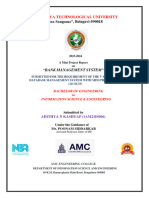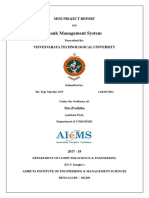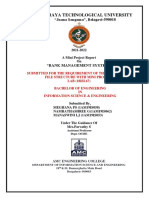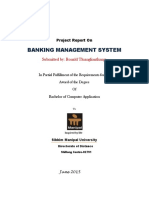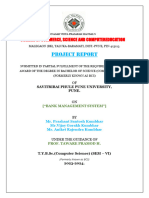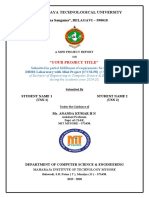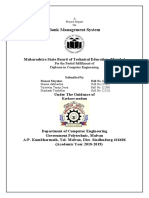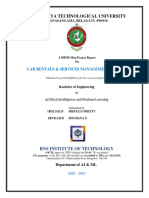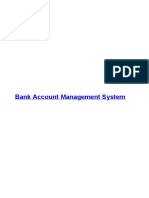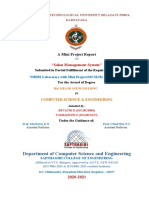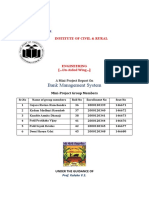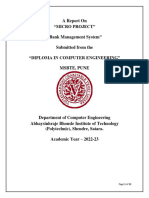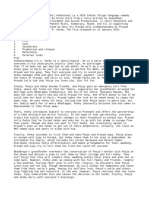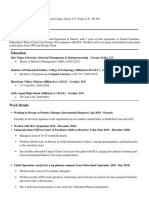Dbms Mini Project Report
Uploaded by
adarshsinha842Dbms Mini Project Report
Uploaded by
adarshsinha842lOMoARcPSD|50863155
dbms mini project report
Dbms, cse (Visvesvaraya Technological University)
Scan to open on Studocu
Studocu is not sponsored or endorsed by any college or university
Downloaded by Aryan Sinha (aryansinha1601@gmail.com)
lOMoARcPSD|50863155
VISVESVARAYA TECHNOLOGICAL UNIVERSITY
“JNANA SANGAMA” , BELAGAVI-590018, KARNATAKA
DBMS Mini-Project Report (21CSL55)
On
S
“BANK MANAGEMENT SYSTEM”
Submitted in the partial fulfillment of the requirement for the award of degree of
BACHELOR OF ENGINEERING
in
COMPUTER SCIENCE AND ENGINEERING
Submitted By
Anurag Kumar 1VA21CS005
Under the Guidance of
Dr. Varun E
Associate Professor
DEPARTMENT OF COMPUTER SCIENCE & ENGINEERING
SAI VIDYA INSTITUTE OF TECHNOLOGY
Approved by AICTE, New Delhi, Affiliated to VTU, Recognized by Govt. of Karnataka.
Accredited by NBA, New Delhi (CSE, ECE, ISE, MECH & CIVIL), NAAC – “A” Grade
Rajanukunte, Bengaluru – 560 064
2023-2024
Downloaded by Aryan Sinha (aryansinha1601@gmail.com)
lOMoARcPSD|50863155
SAI VIDYA INSTITUTE OF TECHNOLOGY
(Approved by AICTE, New Delhi, Affiliated to VTU, Recognized by Govt. of Karnataka.
Accredited by NBA, New Delhi (CSE, ECE, ISE, MECH & CIVIL), NAAC – “A” Grade
Rajanukunte, Bengaluru- 560 064
DEPARTMENT OF COMPUTER SCIENCE & ENGINEERING
CERTIFICATE
This is to Certify that the DBMS Mini-Project(21CSL55) work entitled “BANK
MANAGEMENT SYSTEM” carried out by Mr. Anurag Kumar (1VA21CS005) a bonafide
student of SAI VIDYA INSTITUTE OF TECHNOLOGY, Bengaluru, in partial
fulfillment for the award of Bachelor of Engineering in Department of Computer Science
& Engineering of VISVESVARAYA TECHNOLOGICAL UNIVERSITY, Belagavi
during the year 2023-24. It is certified that all corrections/suggestions indicated for
Internal Assessment have been incorporated in the report. The Mini-Project report has
been approved as it satisfies the academic requirements in respect of DBMS Mini-Project
work prescribed for the said Degree.
Dr. Varun E Dr. Shantakumar B Patil Dr. M S Ganesha Prasad
Associate Professor Professor & HOD Principal
Department of CSE, SVIT Department of CSE, SVIT SVIT
External Viva
Name of the examiners Signature with date
1.
2.
Downloaded by Aryan Sinha (aryansinha1601@gmail.com)
lOMoARcPSD|50863155
ACKNOWLEDGEMENT
The completion of project brings with and sense of satisfaction, but it is never
completed without thanking the persons who are all responsible for its successful
completion. First and foremost, I wish to express our deep sincere feelings of gratitude to
my Institution, Sai Vidya Institute of Technology, for providing me an opportunity to do
our education.
I would like to thank the Management and Prof. M R Holla, Director, Sai Vidya
Institute of Technology for providing the facilities.
I extend my deep sense of sincere gratitude to Dr. M S Ganesha Prasad,
Principal, Sai Vidya Institute of Technology, Bengaluru, for having permitted to carry out
the DBMS Mini-project work on “ BANK MANAGEMENT SYSTEM ” successfully.
I express my sincere gratitude to Dr. Shantakumar B Patil, Professor and HOD,
Department of Computer Science & Engineering, Sai Vidya Institute of Technology,
Bengaluru, for the constant support.
I express my sincere gratitude to Dr. Varun E, Associate Professor, DBMS Mini-
Project Guide, Department of Computer Science & Engineering, Sai Vidya Institute of
Technology, Bengaluru, for his constant support.
Finally, I would like to thank all the Teaching, Technical faculty and supporting
staff members of Department of Computer Science & Engineering, Sai Vidya Institute of
Technology, Bengaluru, for their support.
Anurag Kumar 1VA21CS005
Downloaded by Aryan Sinha (aryansinha1601@gmail.com)
lOMoARcPSD|50863155
ABSTRACT
The Bank Management System presented in this report is a comprehensive web-
based application designed to facilitate efficient management of banking operations.
Developed using PHP, the system encompasses key functionalities, including user
authentication, account management, transaction tracking, and funds transfer. The system
caters to both managers and account holders, providing distinct interfaces tailored to their
respective roles.
For managers, the system offers a centralized dashboard providing an overview of all user
accounts, enabling account deletion, and facilitating the dissemination of notices. The
staff account management and the addition of new accounts are seamlessly integrated,
streamlining managerial tasks. The manager-centric features are complemented by the
ability to gather and address user feedback.
Account holders, on the other hand, benefit from features such as viewing account
balances, accessing account statements, receiving notices, and initiating funds transfers.
The system ensures a secure login process, tracking user-specific transactions, and
presenting a user-friendly interface for a seamless banking experience.
The underlying database structure, implemented in MySQL, captures essential details
related to branches, logins, user accounts, feedback, notices, and transactions. Each
module of the system aligns with the principles of effective database management and
adheres to industry-standard security practices.
The report provides a detailed examination of key PHP scripts responsible for various
functionalities within the Bank Management System. It emphasizes the modular structure,
security considerations, and user experience aspects. Additionally, recommendations for
potential enhancements and further development are discussed.
The Bank Management System serves as an illustrative example of a robust web
application, offering a foundation for future advancements in the realm of banking
technology. The presented codebase and insights provided in this report aim to contribute
to the understanding of web-based banking systems and inspire continued innovation in
the field.
II
Downloaded by Aryan Sinha (aryansinha1601@gmail.com)
lOMoARcPSD|50863155
CONTENTS
ACKNOWLEDGEMENT I
ABSTRACT II
LIST OF FIGURES III
LIST OF TABLES IV
Chapter No Chapter Name Page No
1 INTRODUCTION 1
2 SYSTEM REQUIREMENTS SPECIFICATIONS 3
3 DATABASE DESIGN 6
4 IMPLEMENTATION 9
5 RESULTS & SNAPSHOTS 19
6 CONCLUSION AND FUTURE ENHANCEMENTS 23
7 REFRENCES 24
Downloaded by Aryan Sinha (aryansinha1601@gmail.com)
lOMoARcPSD|50863155
LIST OF FIGURES
Fig No. Figure Name. Page No.
1.1 THE DATABASE MANAGEMENT 2
SYSTEM ARCHITECTURE.
3.1 E-R DIAGRAM NOTATIONS 6
3.2 E-R DIAGRAM OF BANK 7
MANAGEMENT SYSTEM
3.3 BANK MANAGEMENT SYSTEM 8
RELATIONAL SCHEMA
5.1 SNAPSHOT OF HOMEPAGE 19
5.2 SNAPSHOT OF DETAILS SHOWN TO 20
MANAGER
5.3 SNAPSHOT OF FORM FOR NEW USER 20
REGISTRATION
5.4 SNAPSHOT OF USER HOMEPAGE 21
5.5 SNAPSHOT OF FUNDS TRANSFER 21
5.6 SNAPSHOT OF CASHIER’S 22
OPERATIONS
Downloaded by Aryan Sinha (aryansinha1601@gmail.com)
lOMoARcPSD|50863155
LIST OF TABLES
Table No. Table Name Page No
1 TABLES LIST 9
2 BRANCH 9
3 LOGIN 10
4 FEEDBACK 10
5 USERACCOUNTS 11
6 NOTICE 12
7 TRANSACTION 12
Downloaded by Aryan Sinha (aryansinha1601@gmail.com)
lOMoARcPSD|50863155
“Bank Management System”
Chapter 1
INTRODUCTION
The data is scattered across multiple transactional systems, so we have to extract it from
those systems, transform it into a standardized format and finally load it into a central
repository called a data warehouse. The data has to be reorganized so that it is presented to the
users in an understandable way.
“The database Management System” is a system that manages databases and organizes
the data, so that it can be easily retrieved by the users. This system can be used to manage
transactional databases, such as HR systems, banking systems, hospital systems and so on. This
project is typically optimized for performing transactions and it provides discrete pieces of
information for the users.
The database management system organizes the files to give user more control over
their data. The system makes it possible for users to create, edit and update data in database
files. Once created, the system makes it possible to store and retrieve data from those database
files. It provides functions such as concurrency, security, backup, integrity and data
description. It also provides reliability. Database administrators are responsible for creating
backups of databases, controlling access and, in general, making sure it works the way it was
intended.
The system provides automated methods to create, store and retrieve data and also can
make tedious manual tasks a thing of the past. A data base system reduces data redundancy and
inconsistency. It allows for concurrent access by multiple users, each with their own specific
role. Some users only need to view the data, some contribute to adding new data, while others
design and manages the database- all at the same time.
Department of CSE, SVIT, Bengaluru Page 1
Downloaded by Aryan Sinha (aryansinha1601@gmail.com)
lOMoARcPSD|50863155
“Bank Management System”
1.1 Database Management System Architecture
The design of a database management system depends on its architecture. It can be
centralized or decentralized or hierarchical. The architecture of a database management system
can be seen as either single tier or multi-tier. An n-tier architecture divides the whole system
into related but independent n modules, which can be independently modified, altered,
changed, or replaced.
Figure 1.1: The Database Management System Architecture.
Department of CSE, SVIT, Bengaluru Page 2
Downloaded by Aryan Sinha (aryansinha1601@gmail.com)
lOMoARcPSD|50863155
“Bank Management System”
Chapter 2
SYSTEM REQUIREMENT SEPECIFICATION
Software Requirement Specifications (SRS) is an important part of software
development process. SRS includes overall description, functional requirements,
supportability, performance requirement, design constraints, etc. for any applications. These
contents are very much useful in fulfilling the goals while implementing software projects.
2.1 Overall Description
The Bank Management System is a web-based application developed using PHP and
MySQL. It provides a comprehensive platform for managing banking operations, including
staff accounts, user accounts, feedback, and transaction records. The system incorporates
features such as account creation, balance tracking, fund transfers, and notice generation. With
a user-friendly interface, it enables efficient monitoring and administration of bank activities,
enhancing customer interactions and streamlining managerial tasks for a seamless banking
experience.
2.2 Specific Requirements
Many requirements represent stakeholder-defined characteristics the absence of which
will result in a major or even fatal deficiency. Others represent features that may be
implemented if time and budget permits. The requirements must specify a level of importance.
The specification may include a set of use cases that describe interactions the users will have
with the software. It should also include the specifications of hardware and software that are
used for building the software.
2.2.1 Software Requirements
As previously mentioned there are many software that will be part of this project and all
of them are required for development.
Department of CSE, SVIT, Bengaluru Page 3
Downloaded by Aryan Sinha (aryansinha1601@gmail.com)
lOMoARcPSD|50863155
“Bank Management System”
2.2.1.1 MySQL
It is an open source Relational Database Management System (RDBMS) that is under
the GNU GPL and is one of the most widely used. It also allows to scale the project without
much overhead. It also has many features such as high availability, query caching, cross
platform support and security make it a good candidate for deployment. We will be using
MySQL version 5.7.14 which is the latest version.
2.2.1.2 HTML
HTML is a markup language used for structuring and presenting content on the World
Wide Web.HTML includes detailed processing models.HTML5 would be used to design front-
end.
• Operating System : Linux.
• Back End : MySQL.
• Front End : HTML.
• Database Connectivity : Pearl Home Page (PHP).
• Server : Apache.
2.2.2 Hardware Requirements
Most of the current computer have enough specification to implement a database. But we
need to mention some minimal requirement. These would be the minimum specifications to
run the DBMS project. Use cases that describe interactions the users will have with the
software
2.2.2.1 Processor Requirement
A basic fast processor is essential for efficient handling of load during server time and
development time. A processor with minimum 2 cores can handle the workload. Minimum
requirement processor is a Pentium 4(P4). Recommended processor is one with 4 cores like
core i5 Sandy Bridge with larger L3 cache.
Department of CSE, SVIT, Bengaluru Page 4
Downloaded by Aryan Sinha (aryansinha1601@gmail.com)
lOMoARcPSD|50863155
“Bank Management System”
2.2.2.2 Memory Requirements
The RAM memory will be needed to efficiently run the server and the front end, hence at least
2GB of DDR3 RAM would be necessary.
2.2.2.3 Disk Requirement
Python require 100MB of disk space. MySQL requires 1.3GB for Enterprise running.
So in total a minimum of 2GB disk space is required.
• Intel I3 or Above
• 2GB RAM
• 2GB disc space
• Microsoft controllable 101 or more keyboard
Department of CSE, SVIT, Bengaluru Page 5
Downloaded by Aryan Sinha (aryansinha1601@gmail.com)
lOMoARcPSD|50863155
“Bank Management System”
Chapter 3
DATABASE DESIGN
3.1 E-R Diagram
An entity–relationship model (ER model) describes inter-related things of interest in a
specific domain of knowledge. An ER model is composed of entity types (which classify the
things of interest) and specifies relationships that can exist between instances of those entity
types.
ER diagram should have mainly 3 components namely, entity, attribute, relationship.
The following notations can be used for drawing an ER diagram.
Figure 3.1: E-R Diagram Notations.
Department of CSE, SVIT, Bengaluru Page 6
Downloaded by Aryan Sinha (aryansinha1601@gmail.com)
lOMoARcPSD|50863155
“Bank Management System”
Figure 3.2 illustrates key information about bank, including entities such as branches,
customers and accounts. It allows us to understand the relationships between entities.
Figure 3.2: E-R diagram of Bank Management System
Department of CSE, SVIT, Bengaluru Page 7
Downloaded by Aryan Sinha (aryansinha1601@gmail.com)
lOMoARcPSD|50863155
“Bank Management System”
3.2 Relational Schema
The relational schema presented in the provided SQL code outlines the structure of a
comprehensive banking application database. It encompasses essential entities such as
branches, user accounts, login credentials, feedback, notices, and transactions. The schema
employs primary and foreign keys to establish relationships between tables, ensuring data
integrity and efficient retrieval. Auto-incrementing primary keys are implemented for unique
identification of records within their respective tables. This well-designed schema enables the
systematic organization of banking data, providing a foundation for secure user authentication,
account management, transaction tracking, and communication through feedback and notices.
Its flexibility supports future enhancements and optimizations to meet evolving banking system
requirements.
Figure 3.3: Bank Management System Relational Schema.
Department of CSE, SVIT, Bengaluru Page 8
Downloaded by Aryan Sinha (aryansinha1601@gmail.com)
lOMoARcPSD|50863155
“Bank Management System”
Chapter 4
IMPLEMENTATIONS
4.1 RDBMS Tables and their Description
Below table shows the list of tables used in implementation of the Bank Database Management
System.
Table1: All Tables List
mysql> show tables;
+-----------------------+
| Tables_in_Database |
+-----------------------+
| branch |
| login |
| feedback |
| useraccounts |
| notice |
| transaction |
+-----------------------+
branch:
The `branch` table stores unique branch details with `branchId`, `branchNo`, and
`branchName`, facilitating organization and management in the system. Attribute’s and their
description of this table is:
Table2: Branch Details.
mysql> desc branch;
+---------------+-------------+------+-----+---------+-------------+
| Field | Type | Null | Key | Default | Extra |
+---------------+-------------+------+-----+---------+-------------+
| branchId | int | NO | PRI | NULL | |
| branchNo | varchar(10) | YES | | NULL | |
| branchName | varchar(20) | YES | | NULL | |
+---------------+-------------+------+-----+---------+-------------+
Department of CSE, SVIT, Bengaluru Page 9
Downloaded by Aryan Sinha (aryansinha1601@gmail.com)
lOMoARcPSD|50863155
“Bank Management System”
login:
The `login` table manages user credentials with fields like `id`, `email`, `password`, `type`, and
`date`, ensuring secure access and authentication.
Table 3: Login Details
mysql> desc login;
+--------------+-------------+------+-----+---------+---------------+
| Field | Type | Null | Key | Default | Extra |
+--------------+-------------+------+-----+---------+---------------+
| id | int | NO | PRI | NULL |auto_increment |
| email | varchar(30) | YES | | NULL | |
| password | varchar(20) | YES | | NULL | |
| type | varchar(10) | YES | | NULL | |
| date | timestamp | YES | | NULL | |
+--------------+-------------+------+-----+---------+---------------+
feedback:
Stores user feedback with unique IDs, user association, feedback messages, and submission
timestamps for system improvement.
Table 4: Feedback Details.
mysql> desc feedback;
+------------+-----------+------+-----+---------+----------------+
| Field | Type | Null | Key | Default | Extra |
+------------+-----------+------+-----+---------+----------------+
| feedbackId | int | NO | PRI | NULL | auto_increment |
| message | text | YES | | NULL | |
| userId | int | YES | | NULL | |
| date | timestamp | YES | | NULL | |
+------------+-----------+------+-----+---------+----------------+
Department of CSE, SVIT, Bengaluru Page 10
Downloaded by Aryan Sinha (aryansinha1601@gmail.com)
lOMoARcPSD|50863155
“Bank Management System”
useraccounts:
The `useraccounts` table stores user-specific data, such as account details (`name`, `balance`,
`ifsc`, `number`, etc.) and account-related information like `accountNo`, `branch`, and `accountType`.
Table 5: Useraccounts Details.
mysql> desc useraccounts;
+-------------+-------------+------+-----+---------+----------------+
| Field | Type | Null | Key | Default | Extra |
+-------------+-------------+------+-----+---------+----------------+
| id | int | NO | PRI | NULL | auto_increment |
| email | text | YES | | NULL | |
| password | text | YES | | NULL | |
| name | varchar(20) | YES | | NULL | |
| balance | varchar(20) | YES | | NULL | |
| ifsc | varchar(10) | YES | | NULL | |
| number | varchar(20) | YES | | NULL | |
| city | varchar(15) | YES | | NULL | |
| address | varchar(50) | YES | | NULL | |
| accountNo | varchar(10) | YES | | NULL | |
| branch | varchar(20) | YES | | NULL | |
| accountType | varchar(10) | YES | | NULL | |
| date | timestamp | YES | | NULL | |
+-------------+-------------+------+-----+---------+----------------+
Department of CSE, SVIT, Bengaluru Page 11
Downloaded by Aryan Sinha (aryansinha1601@gmail.com)
lOMoARcPSD|50863155
“Bank Management System”
notice:
Manages notices with unique IDs, user associations, notice content, and timestamps, ensuring
effective communication within the system.
Table 6: Notice Details.
mysql> desc notice;
+--------+-----------+------+-----+---------+----------------+
| Field | Type | Null | Key | Default | Extra |
+--------+-----------+------+-----+---------+----------------+
| id | int | NO | PRI | NULL | auto_increment |
| userId | int | YES | | NULL | |
| notice | text | YES | | NULL | |
| date | timestamp | YES | | NULL | |
+--------+-----------+------+-----+---------+----------------+
transaction:
Records diverse financial transactions, utilizing unique IDs, action types, account numbers,
user associations, and chronological timestamps for clarity and tracking.
Table 7: Transaction Details.
mysql> desc transaction;
+---------------+-------------+------+-----+---------+----------------+
| Field | Type | Null | Key | Default | Extra |
+---------------+-------------+------+-----+---------+----------------+
| transactionId | int | NO | PRI | NULL | auto_increment |
| action | varchar(10) | YES | | NULL | |
| credit | varchar(10) | YES | | NULL | |
| debit | varchar(10) | YES | | NULL | |
| accno | varchar(10) | YES | | NULL | |
| userId | int | YES | | NULL | |
| date | timestamp | YES | | NULL | |
+---------------+-------------+------+-----+---------+----------------+
Department of CSE, SVIT, Bengaluru Page 12
Downloaded by Aryan Sinha (aryansinha1601@gmail.com)
lOMoARcPSD|50863155
“Bank Management System”
MySQL Procedure to Store Data from Front End:
Procedure for Validating Login:
DELIMITER $$
CREATE PROCEDURE sp_validateLogin(
IN p_email VARCHAR(30),
IN p_password VARCHAR(20)
BEGIN
SELECT * FROM login WHERE email = p_email AND password =
p_password;
END$$
DELIMITER ;
Procedure for Adding a New User Account:
DELIMITER $$
CREATE PROCEDURE sp_addNewUser(
IN p_email VARCHAR(30),
IN p_password VARCHAR(20),
IN p_name VARCHAR(20),
IN p_balance VARCHAR(20),
IN p_ifsc VARCHAR(10),
IN p_number INT(20),
IN p_city VARCHAR(15),
IN p_address VARCHAR(50),
Department of CSE, SVIT, Bengaluru Page 13
Downloaded by Aryan Sinha (aryansinha1601@gmail.com)
lOMoARcPSD|50863155
“Bank Management System”
IN p_accountNo VARCHAR(10),
IN p_branch INT(3),
IN p_accountType VARCHAR(10),
IN p_date TIMESTAMP
BEGIN
INSERT INTO useraccounts (email, password, name, balance,
ifsc, number, city, address, accountNo, branch, accountType,
date)
VALUES (p_email, p_password, p_name, p_balance, p_ifsc,
p_number, p_city, p_address, p_accountNo, p_branch,
p_accountType, p_date);
END$$
DELIMITER ;
4.2 Connecting To MySQL Using PHP Code
<?php
$con = new mysqli('localhost','root','','mybank');
define('bankname', 'Indian Bank');
$ar = $con->query("select * from userAccounts,branch where
id = '$_SESSION[userId]' AND userAccounts.branch =
branch.branchId");
$userData = $ar->fetch_assoc();
?>
<script type="text/javascript">
$(function () {
$('[data-toggle="tooltip"]').tooltip()
Department of CSE, SVIT, Bengaluru Page 14
Downloaded by Aryan Sinha (aryansinha1601@gmail.com)
lOMoARcPSD|50863155
“Bank Management System”
}) </script>
4.3 Code to Create Web Page:
Session Check: This code checks if the user is logged in. If not, it redirects them to the login
page.
<?php
session_start();
if (!isset($_SESSION['userId'])) {
header('location:login.php');
?>
HTML Head Section: This section includes the HTML head with the title and includes
necessary PHP files for autoloading, database connection, and functions.
<head>
<title>Banking</title>
<?php require 'assets/autoloader.php'; ?>
<?php require 'assets/db.php'; ?>
<?php require 'assets/function.php'; ?>
</head>
Navigation Bar: The navigation bar contains links to different sections of the application and
includes a side button, possibly for user actions.
<nav class="navbar navbar-expand-lg navbar-dark bg-dark fixed-
top">
<!-- Navigation links -->
<?php include 'sideButton.php'; ?>
</nav>
Department of CSE, SVIT, Bengaluru Page 15
Downloaded by Aryan Sinha (aryansinha1601@gmail.com)
lOMoARcPSD|50863155
“Bank Management System”
Content Section: The content section is divided into two columns. The left column contains a
jumbotron with a welcome message and notifications, as well as a carousel for displaying
images. The right column contains cards with buttons for account summary, funds transfer,
notifications, and contact information.
<div class="row w-100">
<!-- Left column with jumbotron and carousel -->
<div class="col" style="padding: 22px;padding-top: 120px">
<!-- Jumbotron with welcome message and notifications -->
<div class="jumbotron shadowBlack" style="padding:
25px;min-height: 241px;max-height: 241px">
<!-- Welcome message and latest notification -->
</div>
<!-- Carousel for displaying images -->
<div id="carouselExampleIndicators" class="carousel slide
my-2 rounded-1 shadowBlack" data-ride="carousel">
<!-- Carousel inner items -->
</div>
</div>
<!-- Right column with card buttons -->
<div class="col">
<!-- Card buttons for account summary, transfer,
notifications, and contact -->
<div class="row" style="padding: 22px;padding-top: 120px">
<!-- Cards with buttons -->
Department of CSE, SVIT, Bengaluru Page 16
Downloaded by Aryan Sinha (aryansinha1601@gmail.com)
lOMoARcPSD|50863155
“Bank Management System”
</div>
</div>
</div>
JavaScript for Tooltip: This script initializes tooltips, possibly for providing additional
information when hovering over certain elements.
<script type="text/javascript">
$(function () {
$('[data-toggle="tooltip"]').tooltip()
})
</script>
4.4 Query to Retrieve Data From Database:
Some queries which are used in the project are listed below:
o select * from useraccounts,branch
where useraccounts.branch = branch.branchId;
It performs a simple join operation between two tables, useraccounts and branch. The
query retrieves all columns (*) from both tables where the branch column in the
useraccounts table matches the branchId column in the branch table.
o select * from login
where type='cashier';
It retrieves all columns (*) from the table named login where the value in the type
column is equal to 'cashier'. This query is filtering the records to only include those
where the user type is specified as 'cashier'.
Department of CSE, SVIT, Bengaluru Page 17
Downloaded by Aryan Sinha (aryansinha1601@gmail.com)
lOMoARcPSD|50863155
“Bank Management System”
o select * from useraccounts,branch
where useraccounts.id = '$_GET[id]'
AND useraccounts.branch = branch.branchId;
It performs a join operation between the tables useraccounts and branch based on the
specified conditions. It selects all columns (*) from both tables where the id column in
the useraccounts table is equal to the provided $_GET[id] value and where the branch
column in the useraccounts table matches the branchId column in the branch table.
o select * from notice
where userId = '$_SESSION[userId]'
order by date desc;
It is used to retrieve records from the notice table where the userId column matches the
value stored in the PHP session variable $_SESSION[userId]. The ORDER BY date
DESC clause arranges the results in descending order based on the date column.
o select * from userAccounts
where email='$user' AND password='$pass';
It is used to retrieve records from the userAccounts table where the email column
matches the provided $user value and the password column matches the provided $pass
value. This query is commonly used for user authentication, checking if a user with a
specific email and password combination exists in the database. If a record is found, it
typically means the user is authenticated and can proceed with the intended action, such
as logging into an application or system.
Department of CSE, SVIT, Bengaluru Page 18
Downloaded by Aryan Sinha (aryansinha1601@gmail.com)
lOMoARcPSD|50863155
“Bank Management System”
Chapter 5
RESULTS
5.1 Output 1
Figure 5.1: Snapshot of Homepage.
Department of CSE, SVIT, Bengaluru Page 19
Downloaded by Aryan Sinha (aryansinha1601@gmail.com)
lOMoARcPSD|50863155
“Bank Management System”
5.2 Output 2
Figure 5.2: Snapshot of details shown to manager.
5.3 Output 3
Figure 5.3: Snapshot of form for new User Registration.
Department of CSE, SVIT, Bengaluru Page 20
Downloaded by Aryan Sinha (aryansinha1601@gmail.com)
lOMoARcPSD|50863155
“Bank Management System”
5.4 Output 4
Figure 5.4: Snapshot of User Homepage.
5.5 Output 5
Figure 5.5: Snapshot of Funds Transfer.
Department of CSE, SVIT, Bengaluru Page 21
Downloaded by Aryan Sinha (aryansinha1601@gmail.com)
lOMoARcPSD|50863155
“Bank Management System”
5.6 Output 6
Figure 5.6: Snapshot of Cashier’s Operations.
Department of CSE, SVIT, Bengaluru Page 22
Downloaded by Aryan Sinha (aryansinha1601@gmail.com)
lOMoARcPSD|50863155
“Bank Management System”
Chapter 6
CONCLUSION AND FUTURE ENHANCEMENTS
6.1. Conclusion
In conclusion, this mini banking project establishes a user-friendly web application for
basic banking operations. It incorporates secure user authentication for customers, managers,
and cashiers. The system provides a visually appealing interface, offering functionalities such
as viewing account information, making fund transfers, and checking notifications. However,
to enhance security, implementing password hashing and further error handling could be
beneficial. Overall, this project serves as a foundation for a robust banking system,
demonstrating fundamental web development and database management skills. Future
improvements may include additional security measures, transaction history tracking, and an
enriched user experience.
6.2 Future Enhancement
The future enhancements for this mini banking project include implementing a robust
transaction history feature for users to track financial activities. Strengthening security
measures with password hashing and introducing multi-factor authentication will fortify user
data protection. Email notifications for transactions and updates, along with user profile
management, will enhance user communication and control. Ensuring a responsive design,
incorporating data encryption, and integrating advanced analytics for user insights will
contribute to a more secure, user-friendly, and feature-rich banking application, meeting
evolving expectations and industry standards.
Department of CSE, SVIT, Bengaluru Page 23
Downloaded by Aryan Sinha (aryansinha1601@gmail.com)
lOMoARcPSD|50863155
“Bank Management System”
REFERENCES
[1] Elmasri, Nawathe, Fundamentals of Database Systems, Pearson Education, 5th Edition,
2006, ISBN- 978-81-317-1625-0.
[2] Raghu Ramakrishnan and Johannes Gehrke, Database Management Systems, Tata
McGraw-Hill, 3rd Edition, 2003, ISBN- 0-07-123151-X.
[3] Silberschatz, Korth and Sudarshan, Database System Concepts, Tata McGraw-Hill, 5th
Edition, 2002, ISBN- 007-124476-X.
[4] H.P. Mooney, J.W. Evans, ‘A complete relational DBMS for an EMS product’, IEEE
Transactions on Power Systems, Volume: 3, Issue: 1, Feb 1988.
[5] Andreas Lubcke , Martin Schaler , Veit Koppen , Gunter Saake, ‘Relational on demand
data management for IT-services’ ,2014 IEEE Eighth International Conference on research
Challenges in Information Science (RCIS), 28-30 May 2014.
Department of CSE, SVIT, Bengaluru Page 24
Downloaded by Aryan Sinha (aryansinha1601@gmail.com)
You might also like
- Visvesvaraya Technological University: "Jnana Sangama", Belagavi-590018No ratings yetVisvesvaraya Technological University: "Jnana Sangama", Belagavi-59001829 pages
- FINAL PROJECT REPORT - Travel Agency Management SystemNo ratings yetFINAL PROJECT REPORT - Travel Agency Management System49 pages
- Mini Project Report (Ashuu, Tavi, Janu) DbmsNo ratings yetMini Project Report (Ashuu, Tavi, Janu) Dbms9 pages
- Visvesvaraya Technological University: Data Base Management SystemNo ratings yetVisvesvaraya Technological University: Data Base Management System7 pages
- Bank Management System: Maharashtra State Board of Technical Education, MumbaiNo ratings yetBank Management System: Maharashtra State Board of Technical Education, Mumbai10 pages
- Department of Computer Science and Engineering: A Mini Project ReportNo ratings yetDepartment of Computer Science and Engineering: A Mini Project Report32 pages
- Assessment Manual For Computer Engineering Program (I Scheme Curriculum)No ratings yetAssessment Manual For Computer Engineering Program (I Scheme Curriculum)17 pages
- "Bank Management System": A Microproject Report OnNo ratings yet"Bank Management System": A Microproject Report On22 pages
- Zimbabwe School Examinations Council: Accounting 9197/350% (2)Zimbabwe School Examinations Council: Accounting 9197/38 pages
- Toyota Mirai FCV Posters LR Tcm-11-564265No ratings yetToyota Mirai FCV Posters LR Tcm-11-56426510 pages
- Automatic Power Cut-Off Device For Electricity Distribution BoardNo ratings yetAutomatic Power Cut-Off Device For Electricity Distribution Board28 pages
- Solid Waste Landfilling Concepts Processes Technology 1st Edition HQ File Fast AccessNo ratings yetSolid Waste Landfilling Concepts Processes Technology 1st Edition HQ File Fast Access315 pages
- The 4 Disciplines of Execution Revised and UpdatedNo ratings yetThe 4 Disciplines of Execution Revised and Updated8 pages
- A Single-Cell and Spatially Resolved Atlas of HumanNo ratings yetA Single-Cell and Spatially Resolved Atlas of Human40 pages
- Electrical and Solar Installation Technology100% (1)Electrical and Solar Installation Technology4 pages


